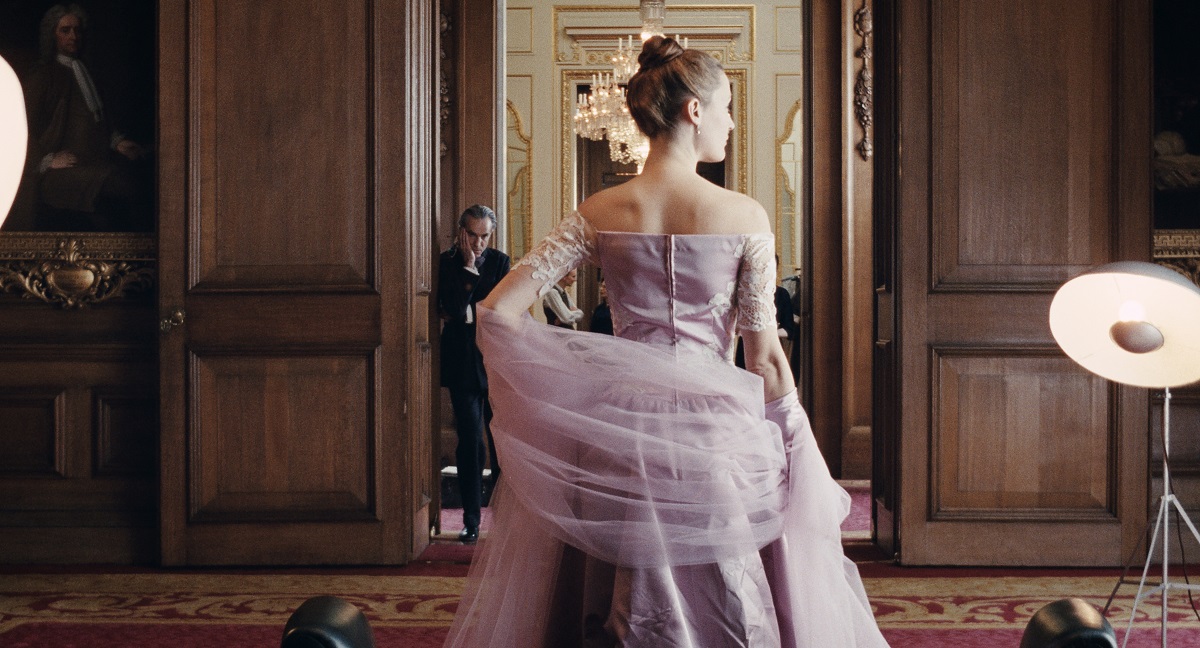The trailer for “Phantom Thread” begins with a meet-cute: pretty waitress Alma (Vicky Krieps) trips over a chair, looking embarrassed and amused as she pulls herself together to see rich fashion designer Reynolds Woodcock (Daniel Day-Lewis) watching her from his table. He seems charmed by her clumsiness and asks her to dinner; the implication is that he could use a little chaos in his regimented life. They’re an odd couple, but opposites attract.
This looks like typical Hollywood romantic comedy territory. Could Paul Thomas Anderson really make something so conventional? His 2002 feature “Punch-Drunk Love” was stylistically eccentric but romantic at its core, with a depressed man finding courage and companionship in a stable woman. “Phantom Thread” seems to promise more of the same, in reverse; an awkward woman and an indulgent man. A trailer, however, isn’t always equivalent to the film it sells. In this case, it (intelligently) comes close to false advertising.
At first, “Phantom Thread” seems to be in love with its male protagonist’s fussiness. Anderson’s sweeping camera combines with Jonny Greenwood’s sensuous orchestral music to highlight the luxurious order of the House of Woodcock. As Reynolds dresses alone, his sister Cyril (Lesley Manville) opens the windows, turns on the lights, and sends an army of seamstresses to work at their tables. Countess Henrietta (Gina McKee) enters and gazes up a spiral staircase at Reynolds, who has prepared her dress. Oscar Peterson’s jazzy version of “My Foolish Heart” embalms the scene in romantic tenderness. The designer and his client hold hands, staring into each other’s eyes with a chaste excitement: the moment has come to try on the garment.
Fussiness has its problems, however. A quick montage of close-ups emphasizes the complexity of the dress’s fastening and how closely its bustier holds the Countess—anxiety and elegance bound together. It is here that Day-Lewis’ performance begins to reveal the alarming degree of Reynolds’ perfectionism: a portrait of the artist as a control freak. Never once looking Henrietta in the face, he manipulates the fabric vigorously, frowning as he turns her around with the clinical focus of a scientist. “Let’s take it for a walk,” he suddenly says smoothly, showing more regard for the dress than its wearer. His own elegant physicality—an extended leg, an imperious hand gesture—contrasts with his client’s discomfort. Henrietta says she’s happy but adds: “after all we’ve been through.” Could this collaboration have been more an ordeal than a privilege?

Paul Thomas Anderson juxtaposes Reynolds’ easy charm and tailored elegance with the suffocating pressure of his process. Everybody seems to think the man is a genius, but the viewer is cued to wonder if his meticulousness is a front for selfishness. Soon, Alma will become our vantage point for this latter perspective. Having established Reynolds’ persona in a series of precise strokes, “Phantom Thread” adopts Alma’s point of view on his behavior. Invited into the House of Woodcock not as a client but a semi-permanent resident, she perceives (and then grabs hold of) the phantom thread running through the designer’s life: a need for control and chosen isolation from the world.
The meet-cute in the trailer embodies Alma’s initial romantic illusions, but the full sequence as presented in the film plays out more sinisterly, anticipating a relationship built on objectification. We see that Reynolds is measuring Alma with his eyes from the moment she trips in front of him, the static camera embodying his voyeuristic composure. When he asks her on a date, the camera angle occludes her face, emphasizing her figure instead. Alma is still seeing him through a haze of fantasy—when he wipes off her red lipstick and tells her “I like to see who I’m talking to,” she’s hypnotized by his practiced seduction. Alma will later reveal in voice-over that Reynolds made her feel beautiful for the first time, but it’s a fine line between graciousness and fetishism.
Reynolds sees through their age and class differences and past Alma’s foreign accent because he wants her for her body—but in a very specific, only quasi-erotic way. Down in his workshop, he asks her to try on a prototype for a new dress. Her amusement at this peculiar form of foreplay fades when things turn mechanical and impersonal. Tape measure in hand, he talks to himself about Alma but does not talk to her, admiring her measurements in a purely functional way. Intimidated and disappointed, she stops smiling and trying to connect with his gaze, instead observing him while he observes her. In a fine bit of physical acting, Krieps becomes more stern and slouchy, like a bored teenager. It isn’t a coincidence that fitting models, employed by fashion houses to have garments made on them for hours on end, are usually older and experienced—and patient—while 16-year-olds focus on the fun of runways.

When Cyril suddenly joins in the process, Alma’s disappointment bursts through fully, and Reynolds finally addresses her, but only to ask her to “stand like before.” By this, he means stand straighter, like an object. Reynolds isn’t interested in Alma as a woman with a personality or emotions. He isn’t even interested in her for sex. She’s his living mannequin. He tells her that she has “no breasts,” and when she looks embarrassed, he adds that she’s “perfect” that way. Cyril takes a similarly passive-aggressive tone, smirking that her brother “loves a little belly.” Standing in her underwear in front of two strangers, Alma is incredulous, unsettled and maybe a bit delighted at being placed on display.
One of the great strengths of Anderson’s script is its innate understanding of the driving forces behind fashion, for designers and models alike. The comments about Alma’s physique speak to the contingent nature of her “perfection;” with her youth, her fair European features and her rather tall and thin but still healthy body, Alma is what a casting agent would call a typical “natural beauty.” This “naturalness” becomes a great asset in the hands of a Reynolds Woodcock. When cloaked in the most exquisite garments, the “naturally beautiful” woman can seem at once effortlessly charming, and too good to be true. She becomes a miraculous product of nature, simultaneously pure and exceptional. Alma’s small breasts ensure that fabric can lay flat on her bust; her slightly imperfect abdomen discreetly reminds one of the person within the dress. Natural beauties bring life to garments.
The last shot of the fitting is a slow-motion, high-angled composition that renders Alma at once statuesque and contorted. The image suggests nothing so much as Pygmalion, with Reynolds as the artist in thrall to His Fair Lady and also bringing her to life. They seem serene and invigorated by the exchange, but as we know, Pygmalion also needed own his creation. Alma isn’t Reynolds’ creation, and she won’t be owned. She is a living, breathing woman and, their meet-cute now a thing of the past, reality sets in—and reality doesn’t stand still.

Alma’s restlessness in later fitting sessions unnerves Reynolds but the true hint that she’s a flesh-and-blood person and not a clothes rack comes from her relationship to food. “Phantom Thread” features no less than six breakfast scenes, each of which hints at a gendered double-standard. Reynolds is irritated by Alma’s simple and unavoidably noisy buttering and munching of her toast in his dining room, and not only because a model isn’t supposed to enjoy food if she is to remain skinny. His meticulousness with his own meals (established with his first, massive breakfast order at Alma’s restaurant) is a laughable attempt to gloss over his repulsive, animalistic voraciousness. He is so unsettled by the physiological need to eat that he’s developed a pathological relationship to food, involving rules and binging. Meanwhile, Alma’s eating is earnest and natural: unlike Reynolds, she’s got nothing to hide.
This unapologetic hunger makes Alma a problematic model, but also a real person, unafraid of the awkwardness of really being alive. Not only doesn’t she mind the crunch of toast, she also enjoys plunging into the unknown by skiing, dancing, having sex (of course, she’s the one who initiates, not Reynolds) and embracing surprises. Her secret, private dinner with Reynolds is a catastrophe because of, again, a double-standard: the designer isn’t averse to surprises when he can impose them on others. In voiceover, Alma explains that Reynolds would often wake her up at ungodly hours to work; and we see him tell his cook that he will have something different—but still precisely outlined by him—for breakfast. He is always the exception to his own rule.
His dresses, when worn, must also follow his rules—the straight lines evinced in his drawings. The wealthy, middle-aged Barbara Rose’s fitting goes terribly partly because she’s a sad drunk, but mostly due to Reynolds’ utter unwillingness to consider her comfort. Echoing “Pygmalion” again, he tells her, “I’m trying to make you beautiful,” while adjusting the choking and ugly collar. When presenting his work to the outside world at his spring fashion show, the fact that nothing, from the shapes of his dresses to Alma’s body, can remain straight, is too much chaos. He suddenly becomes as weak and vulnerable as he was strong and self-sufficient: he needs to sleep and shut his eyes on the inescapable impermanence of the world.

During his first date with Alma, Reynolds had talked at length about the one constant in his life: his late mother, who taught him his trade. In his memory, Mother Woodcock can be always wearing the wedding dress he had sewn her when he was sixteen, always holding the same pose, and always present, whenever he needs her (he’s got a lock of her hair hidden in the lining of his jacket, a phantom thread). In every routine, every dress he designs, every breakfast he orders, with every person he meets, Reynolds is looking to recreate this sense of permanence and security (a colleague and I joked that this is the better 2017 film that could have been titled “mother!”).
Reynolds’ mommy issues are at the heart of his impossible temperament. Like so many of Anderson’s obsessive-compulsive men, he refuses to revise his behavior. Debating with him is pointless. “What precisely is the nature of my game?” he replies condescendingly when she asks him to stop behaving like a needy child. After their disastrous surprise dinner, he bluntly tells Alma to “fuck off.” He cares for his patterns -of his clothes and of life—more than he cares for her.
Alma’s stubbornness keeps her in the House of Woodcock; her plan is to take the place of Reynolds’ phantasmagorical mother. The maternal instincts previously connoted by her “little belly” can make her strong. Reprising her earlier role as a server but also promoting herself to chef, she feeds him poisonous mushrooms and the concoction sends Reynolds to the sunken place she wants him to be in (Sofia Coppola’s “The Beguiled” similarly hinted at the discreet toxic mushroom as a weapon of choice for women). Weak and delirious, he panics and has feverish visions of his mother. But the maternal phantom remains immobile, doesn’t answer his questions, and soon disappears behind Alma. A woman of flesh and blood steps in front of the ghost—a deeply symbolic image of transference.

The next morning, Reynolds barely notices the wedding gown he had damaged, now salvaged. Something else is finally more important to him. He immediately goes to kiss Alma’s feet, like Pygmalion embracing the statue saving him from loneliness. His illness has reminded him of the inescapable end of things. His routines may make every day feel the same, but these days will eventually run out. He may constantly take new muses under his wing to avoid facing a future with any of them, but he himself is inevitably getting older. More importantly still, Alma made him feel safe when facing the harsh reality of time’s passing. She made it so that she would be his sole anchor through the storm—not his mother, not Cyril, not a doctor.
As calculated as the poisoning may be, it is also a sacrifice for Alma because it binds her to her lover. She doesn’t make Reynolds powerless to avenge his objectifying her. Although she does play around with making her own garments, she isn’t interested in competing with Reynolds in his trade: costume designer Mark Bridges has described the red dress she created for her surprise as “a wonderful attempt, a passionate attempt, a little loving hands at home,” and Reynolds himself is unimpressed. Alma’s scheme isn’t a coup to take control from Reynolds’ hands as much as a temporary changing of the guard. She only wants to occasionally overpower Reynolds so that he will submit to her and grant her the privilege of her own submission. When he asks her to marry him after his recovery, her pause is interminable, and Reynolds has to ask, “what the bloody hell are you thinking about?” At this point, he doesn’t know that he’s stepped right in her trap, nor can he understand that she’s about to jump in with him. For Alma, marrying Reynolds means entering a prison of her own making, where both she and her lover have to submit to a ritual of mutual and cyclical overpowering if they hope to both be fulfilled. Here, Anderson argues that romance isn’t the beautiful demonstration of selfless admiration and tenderness that it is often presented to be (and of which a wedding is supposed to be the crystallization). In reality—which is where Alma lives—offering yourself to another is about taking and ceding control.
Eventually, after another suspenseful face-off over mushrooms, Reynolds too comes to understand and accept the poison that will sustain his relationship. He complies with this system that keeps him strong by making him vulnerable and keeps his mannequin docile by letting her feel alive. Although Alma stumbled on furniture when they first met, she can now claim with pride, “no one can stand as long as I can.” In the film’s last shot, we are taken back to that 4 a.m. fitting shown previously, as routine once again stops time. The camera shows Alma and Reynolds’ profiles softly silhouetted against the morning light. Kneeling down, he appears to be bowing down to Alma, but with her back turned to him, she too seems devoted to serving him. After toying with the dress, the designer stands up and his model turns around to face him: finally face-to-face, they smile to each other as each other’s master in submission. Equals at last.











